March 9, 2013
by Robin Parker -
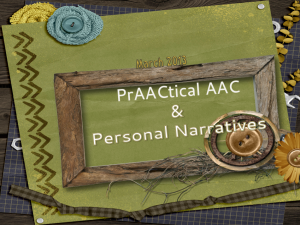
Personal narratives are the first story skills that develop. They tell about ourselves and our connection to activities, places, and events. They tell about how we feel about people and experiences. Personal narratives help us structure and organize the events of our lives and even become a way of thinking about ourselves and our identities. We know many AAC users have significant difficulty with narratives. We always wonder though, is it a function of language difficulty or of access, exposure, and PrAACtice or more likely a combination. There are key intervention strategies that help AAC learners be able to tell personal narratives. You probably won’t be surprised by what strategies work but the research from Gloria Soto and colleagues has shown us that when applied to personal narratives, AAC users can be competent story tellers. Some Thoughts on Personal Narrative Assessment Even before assessment of the AAC learner, in all fairness,... [Read More...]
Filed under: Strategy of the Month
Tagged With: Personal Narratives, teaching strategies
March 2, 2013
by Carole Zangari -
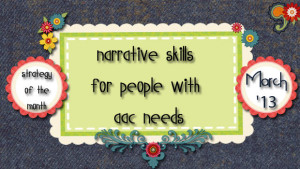
This month, we’ll share some thoughts about helping people with AAC needs develop narrative skills. Why narrative skills? Because they help us connect to one another and communication learning works best when we feel connected. Among other things, storytelling helps us relate to one another. Narrative language is important for reading and writing skills to develop. It helps us understand the world and ourselves. In telling our stories, we establish our identities. Plus, it’s part of what makes life fun. In the US, pediatric therapists are having lots of conversations about the Common Core State Standards (CCSS) in English Language Arts (ELA), and how they relate to the IEP goals of the students that they serve. Many of the goals in the ELA speaking domain require students to be able to summarize what they hear and read, so it is no surprise that SLPs are prioritizing narrative language and related... [Read More...]
Filed under: Strategy of the Month
Tagged With: langage development, narrative language, storytelling, strategy
February 23, 2013
by Robin Parker -
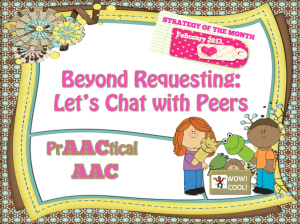
As we wrap up the February Strategy of the Month, we need to add strategies for helping AAC users talk/chat with peers. For some learners, it is more about providing access and opportunity while for others, it is more about providing a platform for the social awareness and exchange. However, for all learners who need assistance in ‘chatting’, there are many goals and strategies that will help. Setting the Foundation for Social Exchanges with Peers Provide frequent opportunities for peers to communicate with each other- Build in many opportunities within all (or almost all) activities for generic small talk, gossiping, & chatting. Create activities that have’ built in’ communication with peers- develop activities that require communication with peers to make the activity work. Instead of having all communication directed at the adults/facilitators in the room, have the learners talk to peers to take steps in the activity. Set up... [Read More...]
Filed under: Strategy of the Month
Tagged With: Social Language
February 16, 2013
by Carole Zangari -

. A few weeks ago we talked about AAC intervention to teach someone how to convey information that others want or need. Giving instructions, answering comprehension questions, and retelling a story all fit into the Light’s category of ‘information transfer.’ Communicating in order to give information is only part of that story. Today, we complete the story by talking about getting information from others. Not all questions are about getting information, of course. We also ask questions for other reasons, like getting something we want or need (e.g., “May I have a drink, please?”) and socializing with friends/family (e.g., “How was your weekend?” “What did you do for your birthday?”). But in this post, we focus on interrogatives that serve the purpose of getting needed information from a communication partner. Many times when we think of interrogatives in language therapy, the focus is on answering them accurately and appropriately. The skill... [Read More...]
Filed under: Strategy of the Month
Tagged With: beyond requesting, interrogatives, language therapy, questions
February 9, 2013
by Robin Parker -
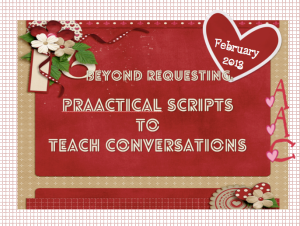
This month’s communication and language strategy goes beyond requesting into conversation. Beginning (and more advanced) communicators can be introduced to conversations through scripts. Scripts for teaching the art of conversation can help give the language to initiate, maintain, extend, and terminate social and conversational exchanges. Scripts can be used to talk about special interests, to participate in activities, and much more. When we teach scripts in a way a learner ‘learns’, the script shows the guidelines, boundaries, and organization of conversations. The communication and language goal is conversation. The strategy to teach conversation is scripts. Scripts are not that foreign to the conversational situation. We all may use scripts at times. Think about your ‘small talk’ scripts or your scripts that help you in unfamiliar or difficult conversations. If learners have difficulty knowing how to participate in conversation, a script can capitalize on strengths like memory and doing well with... [Read More...]
Filed under: Strategy of the Month
Tagged With: Conversation, Scripts
February 2, 2013
by Carole Zangari -

Although it has been close to 25 years since Dr. Janice Light’s hallmark paper on communicative competence in AAC discussed four main purposes of communication, many AAC systems are still heavily populated with messages for basic wants and needs. The other areas – information transfer, social closeness, social etiquette – are often underrepresented in AAC systems. We scratched the surface of how to teach basic requesting last month, and now we’re ready to talk about communicating for other reasons. In this post, we’ll talk about some of the clinical issues in teaching communication for the purpose of information transfer. A big reason that we express ourselves is to share information that others want or need. It may not seem like a high priority until we realize how often we need to do this to function in our daily lives. Here are some examples, both positive and negative, from our work... [Read More...]
Filed under: Strategy of the Month
Tagged With: AAC goals, communicative competence, information transfer, language intervention, strategy
January 26, 2013
by Carole Zangari -
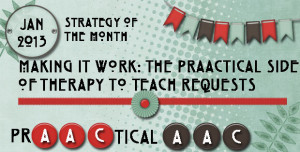
This month we’ve been talking about requesting and choicemaking, specifically how to teach it. Today, we’ll put it into a clinical context by talking about a hypothetical session that targets this skill, but also highlights other strategies. As you read about the materials, preparation, and script, look for how they incorporate strategies such as building specific communication opportunities {CO}, aided language input {ALI}, and expansions {EX}. The clinician also builds in repetition with variety so that there is sufficient opportunities for teaching and practice using multiple modes of communication. In this scenario, you’ll meet Jenna, a 5 year old with significant language difficulties secondary to Cri du Chat syndrome. Jenna’s communication system includes about a dozen manual signs (SIGN), 20-25 word approximations (SPEECH), a few gestures (GEST), some manual communication boards (COMM BD), and an iPad with a full-featured AAC app (iPAD). She also uses movement (MOVEMT), vocalizations (VOC), and... [Read More...]
Filed under: Strategy of the Month
Tagged With: choicemaking, requesting, therapy session
January 19, 2013
by Robin Parker -
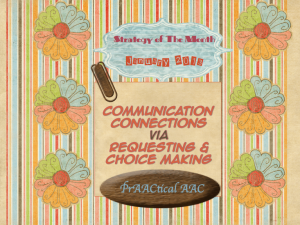
The January Strategy of the Month has focused on requesting and choice making. These are really fun goals to implement. They fall under the communication function that helps us meet our own needs (Behavioral Regulation). When we get what we want, there is a sense of control over the environment & we increase symbolic communication/language, and self-sufficiency. It’s all good. The assumption for all requests and choices is that the learner ‘likes’ what they have asked for. This is what makes the process so much fun, we get to do activities and have interactions that are positive and motivating. If only it was that easy… Sometimes it is not… But do not worry…there are plenty of solutions for common (and not so common) problems when teaching requesting and choice making. As always, set the stage for a positive TEACHING paradigm and then move to problem solving if necessary (and when it is... [Read More...]
Filed under: Strategy of the Month
Tagged With: choice making, preferences, requesting, teaching
January 12, 2013
by Carole Zangari -

Choicemaking and requesting may be the most frequently targeted areas for beginning communicators who are starting out with their AAC systems. That makes sense for some learners because making choices is a very concrete focus for interaction and is loaded with motivational power. It seems pretty straightforward but, like anything else we do clinically, there are lots of decisions and choices to be made as we delve deeper into the process. How can we craft an AAC system that targets requesting for now, but also supports core language learning? For communicators who are at the earliest stages of making requests with AAC symbols, the strategy we discussed earlier this month or simple choice boards are a good starting point. But unless we quickly address where this is all going, the client will be strictly limited in their language learning. There are many ways to do this. Here is one approach.... [Read More...]
Filed under: Strategy of the Month
Tagged With: beginning communicator, choice, choicemaking, core vocabulary, requesting
January 5, 2013
by Carole Zangari -
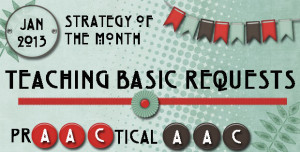
With the start of the new year, we thought it would be a good time to get back to basics. So this month, we’ll talk about the nitty gritty of teaching basic requesting to someone who is first learning to communicate using AAC. For learners who are not sending purposeful communication signals or those who seem unaware that communication involves interaction with another person, we think it makes sense to consider using the PECS curriculum. Why? Because the act of being assisted in physically giving a picture symbol to another person in exchange for a desired object can be an efficient way for someone to gain awareness of two critical principles. First, they learn that communication gives them the power to impact their environment. Secondly, the direct exchange highlights the fact that communication involves two people. As the PECS curriculum is already well established, its procedures will not be addressed... [Read More...]
Filed under: Strategy of the Month
Tagged With: Instruction, language intervention, requesting, teaching









